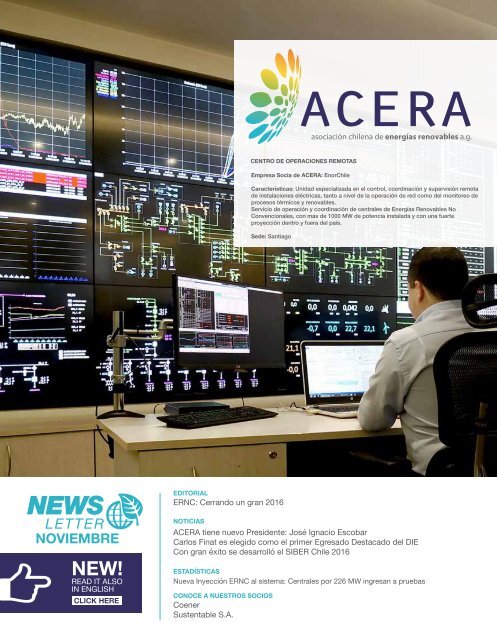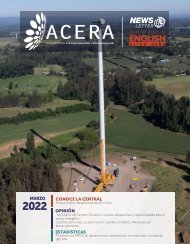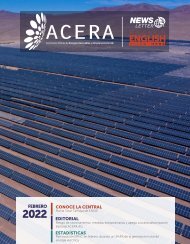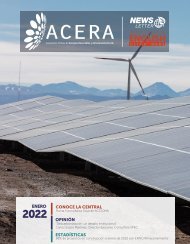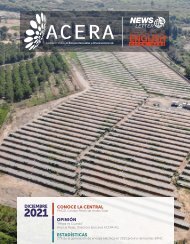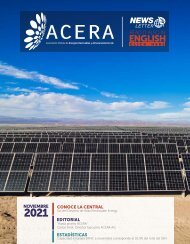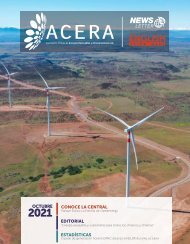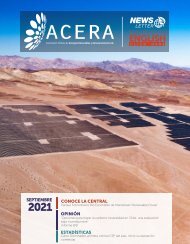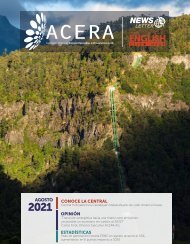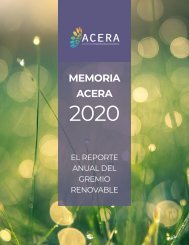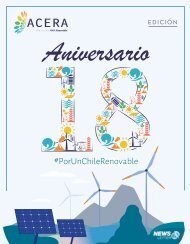Newsletter ACERA - Noviembre 2016
Create successful ePaper yourself
Turn your PDF publications into a flip-book with our unique Google optimized e-Paper software.
CENTRO DE OPERACIONES REMOTAS<br />
Empresa Socia de <strong>ACERA</strong>: EnorChile<br />
Características: Unidad especializada en el control, coordinación y supervisión remota<br />
de instalaciones eléctricas, tanto a nivel de la operación de red como del monitoreo de<br />
procesos térmicos y renovables.<br />
Servicio de operación y coordinación de centrales de Energías Renovables No<br />
Convencionales, con más de 1000 MW de potencia instalada y con una fuerte<br />
proyección dentro y fuera del país.<br />
Sede: Santiago<br />
EDITORIAL<br />
ERNC: Cerrando un gran <strong>2016</strong><br />
NOVIEMBRE<br />
NEW!<br />
READ IT ALSO<br />
IN ENGLISH<br />
CLICK HERE<br />
NOTICIAS<br />
<strong>ACERA</strong> tiene nuevo Presidente: José Ignacio Escobar<br />
Carlos Finat es elegido como el primer Egresado Destacado del DIE<br />
Con gran éxito se desarrolló el SIBER Chile <strong>2016</strong><br />
ESTADÍSTICAS<br />
Nueva Inyección ERNC al sistema: Centrales por 226 MW ingresan a pruebas<br />
CONOCE A NUESTROS SOCIOS<br />
Coener<br />
Sustentable S.A.
EDITORIAL<br />
José Ignacio Escobar<br />
Presidente de <strong>ACERA</strong><br />
ERNC: Cerrando un gran <strong>2016</strong><br />
Reflexionando respecto a lo que fue este <strong>2016</strong>, nos<br />
enorgullece y motiva cerrar el año con cifras tan alentadoras.<br />
Con 3.768MW en operación, 2.106MW en construcción y<br />
aportando más de un 11% de la energía eléctrica total del<br />
país, las ERNC son las protagonistas del sector energético, y<br />
una las principales fuentes de inversión y nuevos empleos<br />
en Chile. Las proyecciones, además, apuntan a que<br />
estaremos llegando a cerca del 30% de energía proveniente<br />
de ERNC al 2020, con más de 8.000MW operando en más<br />
de 10 regiones de nuestro país.<br />
Esta tendencia no es casualidad. En los últimos tres años,<br />
las energías solar fotovoltaica y eólica han sido las dos<br />
tecnologías de mayor inversión en el mundo. Por su parte,<br />
otras ERNC, como CSP, geotermia, pequeñas<br />
hidroeléctricas y la biomasa también han mostrado avances<br />
muy importantes en su competitividad, compartiendo la<br />
tendencia de aumento en la eficiencia y costos decrecientes.<br />
Si sumamos la rapidez de implantación, bajo impacto<br />
ambiental y gran aceptación social, las ERNC se posicionan<br />
como las tecnologías más competitivas para generar<br />
electricidad, por sobre el carbón, gas y la energía nuclear.<br />
Muchos países sueñan con ser 100% renovables para el<br />
2040 o 2050, ya que la tecnología y los precios hoy lo<br />
permiten. En nuestro caso, creemos que es posible y<br />
eficiente que Chile supere la meta de la Política Energética<br />
del 70% de ERNC al 2050, y que llegue al 100%. Para ello<br />
se deben superar algunos desafíos al corto y mediano plazo,<br />
de manera de reducir las brechas regulatorias, sociales y<br />
técnicas que aún enfrentamos.<br />
Algunos de estos desafíos son incorporar a la ley eléctrica<br />
las metas intermedias para llegar y superar la de largo plazo,<br />
poniendo en valor los certificados verdes que permitan<br />
diferenciar estas tecnologías de las contaminantes. También<br />
promover la legislación ambiental, particularmente la<br />
relacionada con el impuesto al CO2, valorizando ese<br />
impuesto de acuerdo al costo real de las externalidades<br />
negativas asociadas el cambio climático y contaminación<br />
local. La modernización de la operación y coordinación de<br />
nuestro sistema eléctrico también es clave, retomando a<br />
cabalidad los temas de eficiencia económica, seguridad en<br />
su más amplio concepto e impacto socio-ambiental.<br />
Finalmente, es necesario impulsar un ordenamiento<br />
territorial claro, apoyado por la sociedad civil, que facilite y<br />
transparente el desarrollo, construcción y operación de<br />
proyectos.<br />
Creemos necesario perfeccionar la evaluación ambiental,<br />
unificando criterios y reforzando el concepto de ventanilla<br />
única, para evitar largos y complejos procesos de<br />
evaluación; impulsar una agenda de interconexión eléctrica<br />
regional, aprovechando las sinergias que se dan con los<br />
países vecinos para un uso eficiente de sus fuentes<br />
energéticas; promover y desarrollar la geotermia, la<br />
mareomotriz y la mini hidro, para que se complementen de<br />
mejor forma en los sistemas eléctricos, poniendo en valor<br />
las características únicas que cada una aporta. Además,<br />
debemos apoyar la incorporación de nuevas tecnologías de<br />
almacenamiento a gran escala, la nueva “energía base” del<br />
mundo, que permitirá reemplazar definitivamente toda<br />
generación fósil existente.<br />
Estamos en una transición única y definitiva hacia una matriz<br />
energética sostenible. Ojalá seamos capaces de acelerarla<br />
aún más y contener el aumento de la temperatura y todos<br />
los nefastos efectos del cambio climático. <strong>ACERA</strong> seguirá<br />
siendo parte activa y protagónica de este cambio.
NOTICIAS<br />
<strong>ACERA</strong> TIENE NUEVO PRESIDENTE<br />
<strong>ACERA</strong> vivió recientemente un cambio en su Directorio, en el cual José<br />
Ignacio Escobar, Gerente General de Acciona Energía y ex Vicepresidente<br />
de la Asociación, asumió como Presidente del gremio de las ERNC. “Es un<br />
orgullo ocupar un puesto tan destacado, en una de las entidades más<br />
importantes y respetadas del sector eléctrico. En estos seis años<br />
colaborando con <strong>ACERA</strong>, he podido ver de cerca cómo ha evolucionado<br />
este sector, con mayor competencia, grandes inversiones y bajos precios<br />
para los consumidores. Nosotros hemos sido parte activa de esta transición<br />
y seguiremos trabajando con más fuerza para eliminar las barreras y superar<br />
los desafíos que aún quedan por salvar”, señaló el Presidente de <strong>ACERA</strong>.<br />
José Ignacio asume el cargo que Alfredo Solar encabezó con mucho éxito<br />
durante los últimos seis años. El puesto de Vicepresidente del gremio lo<br />
asumió Nicolás Caussade, quien se desempeña como Gerente General de<br />
Pattern Energy, y quien tiene una amplia trayectoria en los sectores de<br />
energía y minería.<br />
CARLOS FINAT ES ELEGIDO COMO EL PRIMER EGRESADO<br />
DESTACADO DEL DIE<br />
En el marco de la Cena Anual AlumniDIE, que organiza todos los años la<br />
Facultad de Ciencias Físicas y Matemáticas de la Universidad de Chile, se<br />
realizó por primera vez la premiación del Alumno Destacado, donde se eligió<br />
entre todos los egresados del Departamento de Ingeniería Eléctrica (DIE) al<br />
personaje que más ha resaltado en el último tiempo. El premio fue otorgado<br />
al Director Ejecutivo de <strong>ACERA</strong>, Carlos Finat, Ingeniero egresado del DIE,<br />
con una amplia trayectoria profesional, desarrollada principalmente en las<br />
industrias de energía y minería. Tras la premiación, Finat señaló al respecto<br />
que “es un gran honor ser el primero en recibir este reconocimiento<br />
otorgado por los mismos ex alumnos, habiendo -además- tantos colegas<br />
que se han destacado en sus carreras profesionales tanto en Chile como en<br />
el extranjero”. La Cena, que contó con el patrocinio de <strong>ACERA</strong>, se realizó la<br />
noche del 16 de noviembre y tuvo como invitado especial al ex Ministro de<br />
Energía, Máximo Pacheco Matte, el cual también fue premiado con el<br />
reconocimiento a la Personalidad Pública Destacada.
NOTICIAS<br />
CON GRAN ÉXITO SE DESARROLLÓ EL SIBER CHILE <strong>2016</strong>, EL<br />
ESPERADO EVENTO REGIONAL DE LAS RENOVABLES<br />
Santiago de Chile fue el escenario para la realización del<br />
Cuarto Seminario Iberoamericano de Energías Renovables<br />
(SIBER IV), organizado por la Comisión de Integración<br />
Energética, CIER y la Asociación Chilena de Energías<br />
Renovables, <strong>ACERA</strong>. La actividad contó con la participación<br />
de importantes expositores, tanto nacionales como<br />
internacionales, como el Ministro de Energía, Andrés<br />
Rebolledo, la Ministra de Bienes Nacionales, Nivia Palma<br />
-ambos en representación de Chile-, el Consultor y ex<br />
Viceministro de Energía del Perú, Pedro Gamio, y desde el<br />
Ministerio de Energía y Minería de Argentina, el Subsecretario<br />
de Energías Renovables, Sebastián Kind, quien participó en<br />
la jornada especial del día 16 de noviembre, y el Secretario de<br />
Energía Eléctrica, Alejandro Sruoga, entre otros. Además, en<br />
las ponencias participaron altos ejecutivos de empresas del<br />
sector de energía de la región, consultores y académicos. El<br />
Director Ejecutivo de CIER, Juan José Carrasco, al igual que<br />
el Presidente de <strong>ACERA</strong>, José Ignacio Escobar destacaron el<br />
gran momento que están viviendo las ERNC a nivel nacional<br />
e internacional y lo importante de estas actividades a la hora<br />
de intercambiar conocimientos en cuanto a experiencias. En<br />
la ocasión, el Ministro de Energía de Chile señaló también<br />
que “estamos complacidos de poder realizar esta actividad y<br />
agradecemos que los organizadores hayan pensado en Chile,<br />
porque creemos que es el momento propicio de las ERNC<br />
para el país y la región”.<br />
<strong>ACERA</strong> agradece enormemente la participación de todos los<br />
asistentes al SIBER IV, desarrollado entre los días 17 y 18 de<br />
noviembre en Santiago de Chile y en especial a los<br />
auspiciadores que hicieron posible este evento.<br />
Desde ya los dejamos invitados a apuntar en su agenda el<br />
SIBER V, a realizarse en 2018 en la ciudad de Medellín,<br />
Colombia.<br />
Organizador Auspicio Diamante Auspicio Plata Supporting Sponsor
AVISO
ESTADÍSTICAS<br />
RESULTADOS ERNC<br />
Durante el mes de noviembre de <strong>2016</strong>, el Servicio de Evaluación Ambiental aprobó 4 proyectos ERNC por un total de 123 MW: un proyecto eólico<br />
(24,5 MW) y tres basados en tecnología solar fotovoltaica (98,19 MW), donde se incluye el “Parque Solar Fotovoltaico La Frontera”, de Grenergy<br />
(4,79 MW).<br />
Por otra parte, 3 nuevos proyectos fueron admitidos a calificación durante este mes sumando un total de 237 MW. Se destaca el proyecto eólico<br />
“Santa Ana”, de Mainstream RP (220 MW) y la “Planta Fotovoltaica Los Libertadores”, también de Grenergy (8 MW).<br />
En la resolución exenta número 795 del 24 de noviembre de <strong>2016</strong>, publicada por la CNE, se declararon dos nuevos proyectos ERNC en<br />
construcción, totalizando 12 MW. Ambos corresponden a centrales fotovoltaicas, resaltando “Calama Solar 1”, de SolarPack (9MW). Además,<br />
en dicho documento se anunció que el Proyecto fotovoltaico “El Romero”, de Acciona (196 MW), y el parque eólico “San Juan II”, de Latin<br />
American Power (29,7 MW), entraron en periodo de pruebas.<br />
PROYECTOS ERNC POR ESTADO DE AVANCE<br />
12.000<br />
10.000<br />
Tipo de Tecnología<br />
Potencia (MW)<br />
En operación En construcción Aprobado En calificación Total<br />
8.000<br />
Energía Eólica<br />
1.247<br />
299<br />
6.942<br />
2.295<br />
10.783<br />
6.000<br />
Solar PV<br />
CSP<br />
1.607<br />
0<br />
1.358<br />
110<br />
11.352<br />
1.222<br />
4.673<br />
1.585<br />
18.990<br />
2.917<br />
4.000<br />
2.000<br />
0<br />
Energía Eólica Solar PV CSP Bioenergía Geotérmica Mini hidro ERNC PSH Termosolar<br />
Bioenergía<br />
Geotérmica<br />
Mini hidro ERNC<br />
PSH (Pumped<br />
storage hydro)<br />
Termosolar<br />
Total<br />
481<br />
0<br />
597<br />
0<br />
0<br />
48<br />
22<br />
0<br />
171<br />
70<br />
337<br />
300<br />
120<br />
50<br />
124<br />
0<br />
772<br />
168<br />
1.079<br />
300<br />
39 0 0 0 39<br />
3.970 1.836 20.393 8.847 35.047<br />
Potencia de proyectos en operación (MW)<br />
Potencia de proyectos aprobados (MW)<br />
Potencia de proyectos en construcción (MW)<br />
Potencia de proyectos en calificación (MW)<br />
POTENCIA ERNC INSTALADA Y EN CONSTRUCCIÓN POR SISTEMA<br />
Potencia instalada SIC (MW)<br />
Potencia instalada SING (MW)<br />
Mini hidro ERNC 552<br />
Solar PV 1.234<br />
Mini hidro ERNC<br />
Solar PV<br />
16<br />
365<br />
Energía Eólica<br />
1.149<br />
Energía Eólica<br />
90<br />
Bioenergía<br />
481<br />
Potencia en construcción SIC (MW)<br />
Potencia en construcción SING (MW)<br />
Mini hidro ERNC<br />
22<br />
Solar PV<br />
730<br />
Solar PV<br />
628<br />
CSP<br />
110<br />
Energía Eólica<br />
187<br />
Energía Eólica<br />
112<br />
Geotérmica<br />
48<br />
Energía Eólica<br />
Solar PV CSP Bioenergía Geotérmica Mini Hidro
ESTADÍSTICAS<br />
Durante octubre de <strong>2016</strong>, las ERNC aportaron un 16,05% de la energía total del sistema, lo que acumula un 12,06% en lo que va del año.<br />
La energía solar fue la que más contribuyó con un 4,86%, lo que significó un aumento del 8,82% con respecto a la generación del mes anterior.<br />
Le siguió la energía eólica con un 4,44%, aumentando un 40,08% con respecto a septiembre. La bioenergía estuvo en tercer lugar con 3,61%,<br />
representando un incremento del 4,69%. Finalmente, estuvo la energía proveniente de centrales mini hidro, con un 3,14%, con un aumento del<br />
11,46% con respecto a septiembre de este año.<br />
PORCENTAJE DE PARTICIPACIÓN DE LAS ERNC EN EL SISTEMA<br />
16%<br />
14%<br />
12%<br />
10%<br />
8%<br />
6%<br />
4%<br />
2%<br />
2012 2013 2014 2015 nov.15 dic.15 ene.16 feb.16 mar.16 abr.16 may.16 jun.16 jul.16 ago.16 sept.16 oct.16<br />
Solar Eólico Bioenergía Mini Hidro Total Reconocido Obligación<br />
Porcentaje de participación ERNC Octubre <strong>2016</strong> <strong>2016</strong> YTD<br />
Reconocido<br />
13,58%<br />
Obligación<br />
4,11%<br />
Bioenergía 3,61%<br />
Eólica<br />
4.44%<br />
Hidraúlica<br />
3,14%<br />
Solar<br />
4,86%<br />
Total<br />
16,05%<br />
9,77%<br />
4,21%<br />
3,61%<br />
3%<br />
2,29%<br />
3,15%<br />
12,06%<br />
La información de éste gráfico está desfasada en dos meses.<br />
Fuente de gráficos: Elaboración propia en base a información de CNE, CDEC-SIC, CDEC-SING y SEIA.<br />
BIENVENIDA A LOS<br />
NUEVOS SOCIOS
CONOCIENDO A NUESTROS SOCIOS<br />
Carlos Bravo<br />
JEFE DE PROYECTOS<br />
cbravo@coener.cl<br />
Carlos Bravo es chileno, casado y con un hijo. Es Ingeniero civil Industrial de<br />
la Pontificia Universidad Católica de Chile, con seis años de experiencia en<br />
el sector de las ERNC. Actualmente se desempeña como líder de proyectos<br />
en COENER.<br />
¿Cuáles son los productos o servicios que entrega su empresa y hacia qué tipo(s)<br />
de ERNC?<br />
COENER es una empresa chilena que presta servicios de ingeniería y asesoría en<br />
proyectos ERNC, con más de 10 años de experiencia en el rubro. Participamos en<br />
toda la línea de vida de los proyectos, lo que nos da un valor agregado en cuanto<br />
al conocimiento de la industria. Los servicios que prestamos comprenden<br />
auditorías técnicas y financieras, estudios de factibilidad e ingeniería básica,<br />
ingeniería de detalle eléctrica, desarrollo, gestión y operación de proyectos.<br />
¿Cuáles son las novedades o cambios de su empresa en el último tiempo?<br />
Hemos implementado un servicio de operación en forma remota, que permite el<br />
monitoreo en tiempo real de las plantas generadoras, permitiendo gestionar las<br />
comunicaciones y solicitudes operativas de cada central, con la respectiva<br />
empresa eléctrica y el coordinador del sistema.<br />
¿Cuáles son los principales proyectos -o temas- que están trabajando en el<br />
último tiempo en torno a las ERNC o el medioambiente? En caso de ser plantas<br />
de generación, ¿Dónde se ubican? ¿Cuáles son sus características centrales?<br />
El centro de control y monitoreo de COENER, es uno de los puntos que estamos<br />
fortaleciendo, junto con la adecuación de las centrales ya operativas en función<br />
de los últimos cambios normativos. Además, estamos avanzando en el desarrollo<br />
del proyecto eólico Calbuco, que actualmente se encuentra en etapa de<br />
evaluación ambiental.<br />
¿Qué elementos caracterizan y/o diferencian a su empresa?<br />
Somos una empresa joven, integrada por profesionales de distintas disciplinas<br />
que buscamos constantemente asesorar y brindar soluciones a los<br />
requerimientos de nuestros clientes.<br />
¿Cuál considera que es la importancia de la participación ERNC en el sistema<br />
eléctrico del país?<br />
Consideramos de suma importancia que el desarrollo y crecimiento del país se<br />
encuentre en un equilibrio con el uso de los recursos naturales disponibles.<br />
Gracias a los avances tecnológicos, las ERNC son una alternativa real para<br />
proporcionar energía limpia al país, reduciendo las emisiones de CO2 y<br />
disminuyendo los costos de producción eléctrica.<br />
¿Por qué recomendaría ser socio de <strong>ACERA</strong>?<br />
<strong>ACERA</strong> proporciona un lugar de encuentro entre los diferentes actores del<br />
mercado, facilitando la interacción con otras empresas del rubro. Cumple un rol<br />
activo en promover las ERNC y contribuye al desarrollo de un marco regulatorio<br />
que incentiva el uso de este tipo de tecnologías.<br />
Manuel Silva<br />
GERENTE GENERAL<br />
info@sustentable.cl<br />
Manuel Silva es chileno y Geógrafo de la Universidad de Chile. Desde 1988 ha<br />
trabajado en consultoría y desde 2006 es Gerente General de Sustentable<br />
S.A.<br />
¿Cuáles son los productos o servicios que entrega su empresa y hacia qué tipo(s)<br />
de ERNC?<br />
Sustentable es una empresa de servicios de asesoría y gestión ambiental,<br />
enfocada en elaborar y gestionar la obtención de permisos y autorizaciones<br />
ambientales y sectoriales relacionadas. En el ámbito de las ERNC, hemos<br />
aprobado proyectos minihidro, plantas Fotovoltaicas, termosolares y de biomasa.<br />
¿Cuáles son las novedades o cambios de su empresa en el último tiempo?<br />
Nos adaptamos constantemente al mercado para responder de mejor manera a<br />
los requerimientos de los clientes. Estamos trabajando alianzas con empresas<br />
internacionales, con el fin de poder entregar servicios que solucionen problemas<br />
cada vez más complejos<br />
¿Cuáles son los principales proyectos -o temas- que están trabajando en el<br />
último tiempo en torno a las ERNC o el medioambiente? En caso de ser plantas<br />
de generación, ¿Dónde se ubican? ¿Cuáles son sus características centrales?<br />
Tenemos varios proyectos ERNC en carpeta de desarrollo. Entre ellos está Cerro<br />
Pabellón (geotérmico), de Enel Green Power/ENAP, donde adjudicamos casi<br />
todos los insumos para la L/T que evacuará su energía. Transelec nos otorgó la<br />
Aislación y Soportación de la L/T Maitencillo-Cardones y, también, suministramos<br />
a Siemens el conductor para todas las SS/EE del proyecto en 500KV Cardones –<br />
Polpaico.<br />
¿Qué elementos caracterizan y/o diferencian a su empresa?<br />
Una amplia línea de productos homologados y certificados para la generación,<br />
transmisión y distribución de energía eléctrica. Contamos con una gran<br />
experiencia y con 22 años de reconocimiento como un proveedor serio y<br />
confiable para Proyectos en Alta Tensión.<br />
¿Cuál considera que es la importancia de la participación ERNC en el sistema<br />
eléctrico del país?<br />
Es muy importante para el desarrollo económico y sustentable de nuestro país.<br />
Debemos diversificar nuestra matriz energética y entregar energía renovable a<br />
precios razonables para Chile.<br />
¿Por qué recomendaría ser socio de <strong>ACERA</strong>?<br />
Ser socio de <strong>ACERA</strong> nos permite estar en permanente conocimiento y<br />
comunicación con el mundo ERNC. Representan más del 70% de los proyectos<br />
que se encuentran en construcción, por eso es una fuente vital de información<br />
para nosotros.
<strong>ACERA</strong>, Asociación Chilena de<br />
Energías Renovables A.G.<br />
General del Canto 230, Of 601<br />
Providencia, Santiago<br />
+562 2236 3348<br />
informaciones@acera.cl<br />
@<strong>ACERA</strong>AG<br />
<strong>ACERA</strong>
REMOTE OPERATIONS CENTER<br />
<strong>ACERA</strong>’s Member Company: EnorChile<br />
Characteristics: Unit specialized in the remote control, coordination and supervision of<br />
electric facilities, both at the network operational level and the monitoring of thermal<br />
and renewable processes.<br />
Operation and coordination service of Non-Conventional Renewable Energies centrals,<br />
with over 1000 MW of installed power and with a solid projection in the country and<br />
abroad.<br />
Headquarters: Santiago<br />
EDITORIAL<br />
NCRE: Closing a great <strong>2016</strong><br />
NOVEMBER<br />
NEWS<br />
<strong>ACERA</strong> has a new President<br />
Carlos Finat has been chosen the first DIE’s Outstanding Graduate<br />
SIBER Chile, the expected regional event of renewable energies, took place with<br />
great success.<br />
STATISTICS<br />
New NCRE injection to the system: power plants for 226 MW were admitted to<br />
environmental permit process<br />
MEET OUR MEMBERS<br />
COENER<br />
SUSTENTABLE S.A.
EDITORIAL<br />
José Ignacio Escobar<br />
<strong>ACERA</strong>’s President<br />
NCRE: Closing a great <strong>2016</strong><br />
Thinking about what this <strong>2016</strong> has been, we are proud and<br />
motivated to close the year with such encouraging figures.<br />
With 3,768 MW in operation, 2,106 in construction and<br />
contributing with over 11% of the total country’s electric<br />
power, NCRE are the protagonists of the power sector, and<br />
one of the main investment and new job sources in Chile.<br />
According to the projections, we will be reaching about 30%<br />
of power from NCRE by 2020, with over 8,000MW operating<br />
in more than 10 regions of our country.<br />
This trend is not a coincidence. During the last three years,<br />
solar photovoltaic and wind energies have been the two<br />
technologies with the highest investment in the world. On<br />
the other hand, other NCRE, such as CSP, geothermal, small<br />
hydro and biomass have shown very important advances in<br />
their competitiveness, sharing the trend of increasing<br />
efficiency and decreasing costs. If we add the rapid<br />
implementation, low environmental impact and great social<br />
acceptance, NCRE are becoming the most competitive<br />
technologies in power generation, above coal, gas and<br />
nuclear energy.<br />
Many countries dream of becoming 100% renewable by<br />
2040 or 2050, since technology and prices make this<br />
possible. In our case, we believe it is possible and efficient<br />
that Chile overcomes the Power Policy goal of 70% NCRE<br />
by 2050, achieving a 100%. To this end certain challenges<br />
must be overcome in the short and medium term, in order to<br />
reduce the regulatory, social and technical gaps we are still<br />
facing.<br />
Some of these challenges are to include intermediate goals<br />
in the electric law in order to reach and overcome the<br />
long-term objective, highlighting the green certificates that<br />
allow to differentiate these technologies from the polluting<br />
ones. Another one is to promote environmental legislation,<br />
in particular the one related to the CO2 tax, valuing this tax<br />
according to the actual cost of negative externalities<br />
associated with climate change and local pollution.<br />
We believe it is necessary to improve environmental<br />
assessment, unifying criteria and reinforcing the concept of<br />
one-stop shop, to avoid long and complex evaluation<br />
processes; encourage a regional power interconnection<br />
agenda taking advantage of the existing synergies with our<br />
neighbor countries for an efficient use of their energy<br />
sources; promote and develop geothermal, tidal and mini<br />
hydro energies, so that they supplement each other more<br />
effectively in power systems, taking advantage of each one’s<br />
unique characteristics. In addition, we should support the<br />
introduction of new large-scale storage technologies, the<br />
new “base energy” of the world, which will allow to replace<br />
definitely all existing fossil generation.<br />
We are in a unique and definitive transition towards a<br />
sustainable power matrix. I hope we will be capable of<br />
accelerating it even more and limit the temperature increase<br />
and all the devastating effects of the climate change.<br />
<strong>ACERA</strong> will continue playing an active and leading part in<br />
this change.
NEWS<br />
<strong>ACERA</strong> HAS A NEW PRESIDENT<br />
<strong>ACERA</strong> changed recently its Board of Directors, and Jose Ignacio Escobar,<br />
General Manager of Acciona Energia and former Vice President of the<br />
Association, became President of the NCRE industry. “It is an honor to take<br />
such an important seat in one of the most outstanding and respected entities<br />
within the power sector. During these six years that I’ve worked with<br />
<strong>ACERA</strong>, I could get a close look on how the sector has evolved, with an<br />
increased competition, major investments and low prices for consumers.<br />
We have played an active part in this transition and will continue working<br />
harder to get rid of the barriers and overcome the remaining challenges”,<br />
pointed out <strong>ACERA</strong>’s President. Jose Ignacio has come to replace Alfredo<br />
Solar, who led the industry in a very successful way over the last six years.<br />
The new Vice President is Nicolas Caussade, General Manager of Pattern<br />
Energy, with a wide experience in energy and mining sectors.<br />
CARLOS FINAT HAS BEEN CHOSEN THE FIRST DIE’S OUTSTANDING<br />
GRADUATE<br />
As part of the DIE Alumni Annual Dinner, organized every year by the<br />
Physical and Mathematical Sciences Faculty of the Universidad de Chile, the<br />
Outstanding Sudent Award was granted for the first time, aimed at the most<br />
outstanding graduate of the Electrical Engineering Department (DIE) in the<br />
last time. The prize was awarded to <strong>ACERA</strong>’s Executive Director, Carlos<br />
Finat, an engineer graduated from the DIE, with a wide professional<br />
experience, mainly in the energy and mining industries. After receiving the<br />
award, Finat stated that “it is an honor to be the first one to receive this<br />
recognition granted by the alumni themselves, moreover when there are so<br />
many colleges that have stood out in their professional careers, both in Chile<br />
and abroad”. The dinner, sponsored by <strong>ACERA</strong>, was held on November 16,<br />
and had as a special guest the former Minister of Energy, Maximo Pacheco<br />
Matte, who received the Outstanding Public Figure Award.
NEWS<br />
SIBER CHILE, THE EXPECTED REGIONAL EVENT OF RENEWABLE<br />
ENERGIES, TOOK PLACE WITH GREAT SUCCESS.<br />
Santiago, Chile, was the location where the Fourth<br />
Iberoamerican Renewable Energies Seminar (SIBER IV) took<br />
place, organized by the Energy Integration Commission,<br />
CIER, and the Chilean Renewable Energy Association,<br />
<strong>ACERA</strong>. The activity was attended by important speakers,<br />
both national and international, such as the Minister of<br />
Energy, Andres Rebolledo, the Minister of Public Lands, Nivia<br />
Palma -both representing Chile-, the Consultant and former<br />
Deputy Minister of Energy of Peru, Pedro Gamio, and, from<br />
the Energy and Mining Ministry of Argentina, the<br />
Undersecretary of Renewable Energies, Sebastian Kind, who<br />
took part in the special event on November 16, and the<br />
Secretary of Electric Energy, Alejandro Sruoga, among<br />
others. In addition, lectures were given by high executives of<br />
the regional energy sector companies, consultants and<br />
professors. CIER’s Executive Director, Juan Jose Carrasco,<br />
and <strong>ACERA</strong>’s President, Jose Ignacio Escobar, highlighted<br />
the great moment that the NCRE are living both at the<br />
national and international level, and the importance of these<br />
activities when it comes to exchange knowledge concerning<br />
experience. The Chilean Minister of Energy also pointed out<br />
that “we are pleased to be able to carry out this activity and<br />
we appreciate that the organizers considered Chile, since we<br />
believe this is the appropriate time of NCRE in the country<br />
and the region”.<br />
<strong>ACERA</strong> appreciates enormously the participation of all the<br />
attendants to SIBER IV, which took place on November 17<br />
and 18 in Santiago, Chile, especially to the sponsors which<br />
made this event possible.<br />
We invite you to put SIBER V on your agenda, which will take<br />
place in 2018 in Medellin, Colombia.<br />
Organizador Auspicio Diamante Auspicio Plata Supporting Sponsor
ADVERTISEMENT
STATISTICS<br />
NCRE RESULTS<br />
During the month of November <strong>2016</strong>, the Environmental Assessment Service granted the environmental approval to 4 NCRE projects, for a total<br />
of 123 MW: one wind Project (24.5 MW) and three based on solar photovoltaic technology (98.19 MW), which include the “La Frontera Solar”<br />
Photovoltaic Park, of Grenergy (4.79 MW).<br />
On the other hand, 3 new projects were admitted to environmental permit process during this month, adding 237 MW. Among them, the “Santa<br />
Ana” wind Project, of Mainstream RP (220 MW) and the “Los Libertadores” Photovoltaic Plant, also of Grenergy (8 MW), must be pointed out.<br />
In the Exempt Resolution Nº 795 of November 24, <strong>2016</strong>, published by the CNE, 2 new NCRE projects were declared in construction, totaling 12<br />
MW. Both are photovoltaic plants, of which “Calama Solar 1”, of SolarPack (9 MW) must be highlighted. In addition, the abovementioned<br />
document announces that the “El Romero” photovoltaic project, of Acciona (196 MW), and the “San Juan II” wind park, of Latin American Power<br />
(29.7 MW) began their test period.<br />
NCRE PROJECTS BY STATUS<br />
12.000<br />
10.000<br />
Technology<br />
Capacity (MW)<br />
Installed Under construction Approved<br />
Admitted to<br />
environmental<br />
permit process<br />
Total<br />
8.000<br />
Wind energy<br />
1.247<br />
299<br />
6.942<br />
2.295<br />
10.783<br />
6.000<br />
Solar PV<br />
CSP<br />
1.607<br />
0<br />
1.358<br />
110<br />
11.352<br />
1.222<br />
4.673<br />
1.585<br />
18.990<br />
2.917<br />
4.000<br />
2.000<br />
0<br />
Wind energy Solar PV CSP Bioenergy Geothermal Mini hydro NCRE PSH Termosolar<br />
Installed capacity (MW)<br />
Capacity under construction (MW)<br />
Bioenergy<br />
Geothermal<br />
Mini hydro NCRE<br />
PSH (Pumped<br />
storage hydro)<br />
Thermosolar<br />
Total<br />
481<br />
0<br />
597<br />
0<br />
0<br />
48<br />
22<br />
0<br />
171<br />
70<br />
337<br />
300<br />
120<br />
50<br />
124<br />
0<br />
772<br />
168<br />
1.079<br />
300<br />
39 0 0 0 39<br />
3.970 1.836 20.393 8.847 35.047<br />
Approved capacity (MW)<br />
Capacity admitted to environmental permit process (MW)<br />
INSTALLED AND UNDER CONSTRUCTION NCRE POWER PER SYSTEM<br />
SIC installed capacity (MW)<br />
Mini hydro NCRE 552<br />
Solar PV 1.234<br />
Wind energy 1.149<br />
Bioenergy 481<br />
SING installed capacity (MW)<br />
Mini hydro NCRE 16<br />
Solar PV 365<br />
Wind energy 90<br />
SIC under construction capacity (MW)<br />
SING under construction capacity (MW)<br />
Mini hydro NCRE 22<br />
Solar PV 628<br />
Wind energy 187<br />
Solar PV<br />
CSP<br />
Wind energy<br />
Geothermal<br />
730<br />
110<br />
112<br />
48<br />
Wind energy<br />
Solar PV CSP Bioenergy Geothermal Mini hydro NCRE
STATISTICS<br />
During October <strong>2016</strong>, NCRE’s contribution to the total energy system amounted to 16.05%, accumulating 12.06% throughout<br />
the year.<br />
The highest contribution was solar energy, with a 4.86%, which represents an 8.82% increase as compared to the prior month,<br />
followed by wind energy, with a 4.44%, representing a 40.08% as compared to September. Bioenergy was placed third, with a<br />
3.61%, representing a 4.69% increase, and finally, energy from mini hydro sources was placed fourth, with a 3.14%, representing<br />
a 11.46% increase as compared to September of this year.<br />
NCRE’S PERCENTAGE OF PARTICIPATION<br />
16%<br />
14%<br />
12%<br />
10%<br />
8%<br />
6%<br />
4%<br />
2%<br />
2012 2013 2014 2015 nov.15 dec.15 jan.16 feb.16 mar.16 apr.16 may.16 jun.16 jul.16 aug.16 sept.16 oct.16<br />
Solar Wind Bioenergy Mini hydro NCRE Total Recognized Legal Requirement<br />
NCRE’s percentage of participation October <strong>2016</strong> <strong>2016</strong> YTD<br />
Recognized<br />
13,58%<br />
9,77%<br />
Legal Requirement<br />
4,11%<br />
4,21%<br />
Bioenergy<br />
3,61%<br />
3,61%<br />
Wind<br />
4.44%<br />
3%<br />
Mini hydro NCRE<br />
3,14%<br />
2,29%<br />
Solar PV<br />
4,86%<br />
3,15%<br />
Total<br />
16,05%<br />
12,06%<br />
Information in this graphic is two months behind<br />
Source of graphics: Developed by <strong>ACERA</strong> based on information from CNE, CDEC-SIC, CDEC SING and SEIA<br />
WELCOME TO<br />
NEW MEMBERS
MEET OUR MEMBERS<br />
Carlos Bravo<br />
PROJECT MANAGER<br />
cbravo@coener.cl<br />
Carlos Bravo is Chilean, married, and has one son. He is an Industrial Civil<br />
Engineer from the Pontificia Universidad Católica de Chile, with six years of<br />
experience in the NCRE sector. At present he is Project Manager of<br />
COENER.<br />
What products or services does your company deliver and to what kind(s) of<br />
NCREs?<br />
COENER is a Chilean company which has been delivering engineering and<br />
advisory services on NCRE projects for over 10 years. We participate in all the life<br />
cycle of the projects, which provides us with an added value concerning the<br />
industry know-how. Our services comprise technical and financial auditing,<br />
feasibility and basic engineering studies, electrical detail engineering, as well as<br />
project development, management and operation.<br />
What are the main projects -or themes- you have been recently working on<br />
concerning NCRE or the environment? In case they are generation plans, where<br />
are the located and which are their main characteristics?<br />
We are strengthening COENER’s control and monitoring center, and adjusting the<br />
operating central to the last regulatory changes. We are also developing the<br />
Calbuco wind project which is currently in its environmental assessment stage.<br />
Which elements characterize and/or distinguish your company?<br />
We are a young company, formed by professionals of different disciplines, looking<br />
forward to advise and provide solutions to our customers’ requirements.<br />
How important is NCRE participation in the Chilean electric system?<br />
We believe it is very important that the development and growth of the country is<br />
balanced with the use of available natural resources. Thanks to technology<br />
advances, NCRE are a real alternative to provide clean energy to the country,<br />
reducing CO2 emissions and lowering electricity production costs.<br />
Why would you recommend being an <strong>ACERA</strong> member?<br />
<strong>ACERA</strong> provides a meeting point for the different market actors, enabling the<br />
interaction with other companies in the industry. It carries out an active role in<br />
NCRE promotion and contributes to the development of a regulatory framework<br />
that encourages the use of this kind of technologies.<br />
Which have been the latest new services or changes introduced by your<br />
Company?<br />
We have implemented a remote operational service which allows a real-time<br />
monitoring of power plants. In this way, we are able to manage the<br />
communications and operating requirements of each plant with the related<br />
electric company and the system coordinator.<br />
Manuel Silva<br />
GENERAL MANAGER<br />
info@sustentable.cl<br />
Manuel Silva is Chilean and a Geographer from the Universidad de Chile. He<br />
has worked as a consultant since 1988 and since 2006 is the General<br />
Manager of General de Sustentable S.A.<br />
What products or services does your company deliver and to what kind(s) of<br />
NCREs?<br />
Sustentable is a Company that provides advisory and environmental<br />
management services, mainly focused on elaborating and managing<br />
environmental and sectoral permits and authorizations. As far as NCRE is<br />
concerned, we have approved mini hydro projects and photovoltaic, thermosolar<br />
and biomass plants.<br />
Which have been the latest new services or changes introduced by your<br />
Company?<br />
We are constantly adapting to the market in order to meet in a better way our<br />
customers’ requirements. We are establishing alliances with international<br />
companies that will allow us to deliver services solving increasingly complex<br />
problems.<br />
What are the main projects -or themes- you have been recently working on<br />
concerning NCRE or the environment? In case they are generation plans, where<br />
are the located and which are their main characteristics?<br />
We have been developing various Environmental Impact Statements and<br />
Studies, among which we can mention: Hueñivales Hydroelectric power plant<br />
(Study, IX region), Cipresillos run-of-river mini hydro (Study, VI region), La Tonada<br />
solar plant (Statement, V region), El Galpon run-of-river mini hydro (Statement,<br />
VII region) and Cerro Dominador photovoltaic plant (Statement, II region).<br />
Which elements characterize and/or distinguish your company?<br />
Our knowledge of environmental legislation, jurisprudence and regulatory<br />
changes, gathered from a 16-year presence, allow us to offer excellent advisory<br />
services.<br />
How important is NCRE participation in the Chilean electric system?<br />
NCRE play a key role, since we have optimal conditions for their implementation<br />
along the country with a lower environmental cost as compared to fossil fuels<br />
and a higher supply stability.<br />
Why would you recommend being an <strong>ACERA</strong> member?<br />
We believe <strong>ACERA</strong>’s main value is the people that compose it, both its<br />
leadership and members, since they are active and competent actors in the<br />
NCRE market. This brings up a constant discussion of issues related to them,<br />
where you can find different views and experiences from an interdisciplinary,<br />
highly prepared group of professionals.
<strong>ACERA</strong>, Chilean Association of<br />
Renewable Energies A.G.<br />
General del Canto 230, Of 601<br />
Providencia, Santiago<br />
+562 2236 3348<br />
informaciones@acera.cl<br />
@<strong>ACERA</strong>AG<br />
<strong>ACERA</strong>


